新概念英语第一册词汇句型总复习
新概念英语第一册重点句型总结
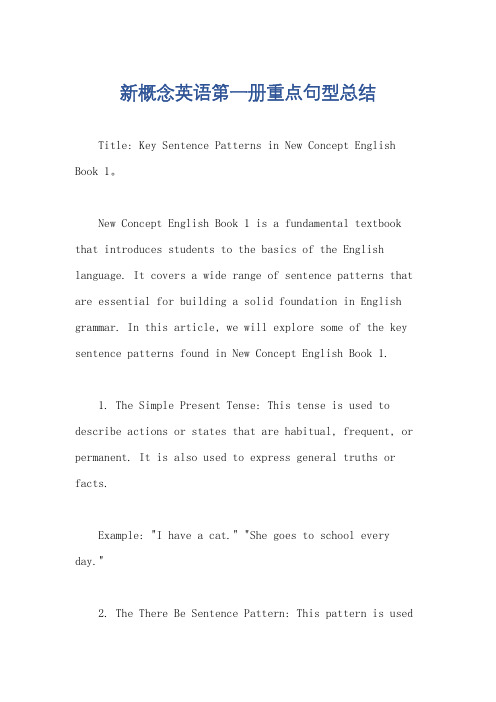
新概念英语第一册重点句型总结Title: Key Sentence Patterns in New Concept English Book 1。
New Concept English Book 1 is a fundamental textbook that introduces students to the basics of the English language. It covers a wide range of sentence patterns that are essential for building a solid foundation in English grammar. In this article, we will explore some of the key sentence patterns found in New Concept English Book 1.1. The Simple Present Tense: This tense is used to describe actions or states that are habitual, frequent, or permanent. It is also used to express general truths or facts.Example: "I have a cat." "She goes to school every day."2. The There Be Sentence Pattern: This pattern is usedto express the existence of something or someone in a particular place.Example: "There is a book on the table." "There are two cats in the garden."3. The Simple Past Tense: This tense is used to describe actions or events that have already happened in the past.Example: "I went to the park yesterday." "She bought a new dress last week."4. The Simple Future Tense: This tense is used to express actions or events that will happen in the future.Example: "I will go to the doctor tomorrow." "They will meet at the station at 10 a.m."5. The Present Continuous Tense: This tense is used to describe actions that are happening now or are in progress.Example: "I am studying now." "She is cooking dinner."6. The Basic Question Formation: Questions in English are formed by inverting the subject and verb. This pattern is used for yes/no questions and wh-questions.Example: "Are you a student?" "What is your name?"7. Imperative Sentences: These sentences are used to give commands or make requests. They are formed by using the base form of the verb.Example: "Close the door, please." "Don't forget to bring your book."8. The Basic Affirmative and Negative Sentences: Affirmative sentences express a positive statement, while negative sentences express a denial or opposition.Example: "I like coffee." (Affirmative) "I don't like coffee." (Negative)。
新概念英语第一册复习一

第一篇基本词句一、基本句子(牢记):Excuse me!不好意思!打拢了——Is this your handbag? 这是你的手提包吗?——Yes,it is. 是,这是我的手提包。
——No,it isn't. 不,这不是我的手提包。
——How are you today? 你今天感觉如何?——I'm fine,thank you. 我很好,谢谢你。
How do you do? 您好(初次见面,正式打招呼时)——Nice to meet you. 很高兴认识你。
——Nice to meet you,too. 我也是。
——what is your job? 你有职业是什么?——I am an English teacher. 我是一名英语老师。
——what colour is your dress? 你的裙子是什么颜色?——My dress is blue. 我的裙子是蓝色的。
——Are you French? 你是法国人吗?——Yes,I am. 是的,我是法国人。
——No,I am not. 不,我不是。
——What nationality are you? 你的国籍是哪里?——I am French. 我是法国人。
——I am American. 我是美国人。
——Which one? 哪一个?——The red one. 红色的那个。
——Which ones? 哪些?——The red ones. 红色的那些。
——Where is it? 它在哪里?——It's on the desk. 它在书桌上。
——Where are they? 他们在哪里?——They are in the kitchen. 他们在厨房。
What's the weather like today? 今天天气如何?What's he/she/it doing? 他/她/它在做什么?——What's are they doing?他们正在做什么?——They are doing their homework.他们正在做家庭作业。
新概念英语第一册各课语法知识汇总
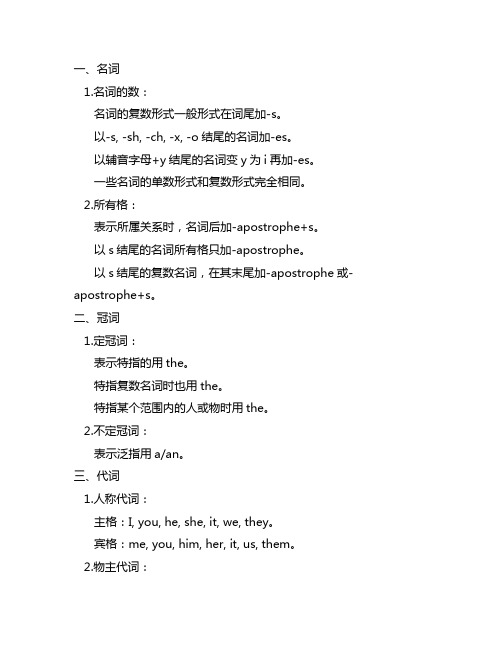
一、名词1.名词的数:名词的复数形式一般形式在词尾加-s。
以-s, -sh, -ch, -x, -o结尾的名词加-es。
以辅音字母+y结尾的名词变y为i再加-es。
一些名词的单数形式和复数形式完全相同。
2.所有格:表示所属关系时,名词后加-apostrophe+s。
以s结尾的名词所有格只加-apostrophe。
以s结尾的复数名词,在其末尾加-apostrophe或-apostrophe+s。
二、冠词1.定冠词:表示特指的用the。
特指复数名词时也用the。
特指某个范围内的人或物时用the。
2.不定冠词:表示泛指用a/an。
三、代词1.人称代词:主格:I, you, he, she, it, we, they。
宾格:me, you, him, her, it, us, them。
2.物主代词:形容词性物主代词:my, your, his, her, its, our, their。
名词性物主代词:mine, yours, his, hers, its, ours, theirs。
3.指示代词:this, that, these, those。
4.不定代词:some, any, no, every, each, many, much, few, little。
四、形容词1.形容词的用法:在名词前作定语。
在系动词之后作表语。
2.比较级和最高级:比较级:比较两者时,用比较级。
最高级:表示三者或三者以上之间的比较。
五、动词1.动词的三单形式:一般情况,动词第三人称单数在末尾加-s。
以辅音字母加y结尾的动词变y为i再加-es。
直接在词尾加-es的动词。
2.动词的现在进行时:am/is/are+动词的现在分词。
3.行为动词的过去式:动词过去式变化规则有规则动词和不规则动词。
六、副词1.副词的用法:修饰动词、形容词、副词。
表示时间、地点、原因、目的等。
2.比较级和最高级:副词比较级和最高级的构成。
七、介词1.介词的基本用法:表示方位、时间、原因、目的等。
新概念英语第一册语法归纳全篇

可编辑修改精选全文完整版新概念英语第一册语法归纳新概念英语第一册语法归纳《新概念英语》作为一套世界闻名的英语教程,以其全新的教学理念,有趣的课文内容和全面的技能训练,深受广大英语学习者的欢迎和喜爱。
以下店铺为大家整理的新概念英语第一册语法归纳,欢迎阅读!新概念英语第一册语法归纳篇1感叹句感叹句:1)What +名词+主语+谓语What a beautiful girl she is!What tall buildings they are!2)How +形容词+主语+谓语How beautiful the girl is!How tall the buildings are!在口语中,感叹句的主语和谓语常常省略:What a nice present!(省略it is)How disappointed!(省略she is或其它可作本句主、谓的词语) 祈使句祈使句表示请求、命令、建议、邀请等,谓语动词一律用原型,句子中通常不用主语,句末用惊叹好或者句号,用降调。
肯定句:动词原型Come here,please.Go downstairs,please.Stand up.Sit down.Be quiet.Be careful.祈使句中如果有唤语,一定要用逗号隔开,放在句首或者句尾:Come in,Amy.Sit down here,Tom.Mary,give me a book please.否定:Don't+动词原型Don't come here.Don't sit down.Don't stand up.Don't give me it.let sb. do 让某人做Let me pass.Let us have a rest.Let's have a rest.反意疑问:Let's have a walk along the river,shall we?Let us go out for a drink,will you?so/neither的倒装倒装句:so/neither的倒装eg: He can swim. So can I.She didn't go to class. Neither did I.结构:so/neither+be+ 主语so/neither+助动词+ 主语so/neither+情态动词+ 主语助动词:一般现在时: do,does/am,is,are现在进行时: am,is,are一般过去时: did现在完成时: have,has一般将来时: will,shall过去进行时: was,were过去完成时: had过去将来时: would直接引语/间接引语如果引语的主句所用动词为过去时,那么间接引语要做相应变化:时态,人称,时间地点及指示词1)时态变化:一般现在时——一般过去时现在进行时——过去进行时一般过去时——过去完成时现在完成时——过去完成时一般将来时——过去将来时be going to——was/were going to/wouldcan--couldmay--might2)时间地点及指示词的变化:here-there,tomorrow-the next day,the following day,this-that…3)人称变化:根据句意改变人称。
新概念第一册英语全面语法总结

新概念英语第一册1-72课语法点总结1.物主代词2.人称代词3.Be动词Be动词在一般现在时的三个变形:am, is, areBe动词在一般过去时的两个变形:was, were●注意: Be动词要根据主语的变化而变化。
4.一般疑问句定义:一般疑问句是指可以用Yes或者No回答的句子。
肯定句变为一般疑问句:若一个肯定句中存在Be动词am, is, are,则直接将Be动词提前,结尾加问号。
若一个肯定句中存在情态动词,则直接将情态动词提前,结尾加问号。
若一个肯定句中存在实义动词,则直接在句首加助动词do/does/did,实义动词变原形,结尾加问号。
●注意:一般疑问句一般读为升调。
例:Are you a teacher? 你是一名老师吗?肯定回答:Yes, I am. 否定回答:No, I am not.Do you like English? 你喜欢英语吗?肯定回答:Yes, I do. 否定回答:No, I don’t.5.特殊疑问句定义:不能用Yes或者No回答的句子。
构成:特殊疑问词 + 一般疑问句特殊疑问词:what(什么), when(何时), where(何地), who(谁), whom (谁宾格), whose(谁的), which(哪个), why(为什么), how(怎么样)口诀:非常八加一6.不定冠词a/an若单词是以“a, e, i, o”四个元音开头,其前面选用“an”;若单词是以元音字母“u”开头,视情况而定。
若其发音与“umbrella”中的“u”一致,则前面加“an”;若其发音与“university”中的“u”一致(即发字母本身音时),前面加“a”。
若单词是以辅音字母开头,一般前面用a。
特殊:an hour 一个小时;an honest boy 一个诚实的男孩若一个字母单独出现时,分如下情况:加an的字母:a, e, i, o(元音); x, r, s, l, n, f, m, h (辅音;口诀为“学而思送来那份美好”)例: There is an “m” in the word “umbrella”. 在单词umbrella里面有一个字母m。
新概念第一册每课知识点整理

新概念第一册每课知识点整理Lesson 1 - Excuse me!一、重点单词。
1. excuse.- 作动词,意为“原谅;宽恕”,例如:Excuse me.(打扰一下。
)- 作名词,意为“借口;理由”,如:Don't make excuses.(不要找借口。
)2. me.- 人称代词宾格,“我”,在句中作宾语,如:Give it to me.(把它给我。
)二、重点句型。
1. Excuse me!- 用于引起别人注意、请求让路、打断别人说话等场合,是比较礼貌的用法。
三、语法点。
简单的日常交际用语的使用。
Lesson 2 - Is this your…?一、重点单词。
1. pen.- 名词,“钢笔”。
2. pencil.- 名词,“铅笔”。
3. book.- 名词,“书”。
4. watch.- 名词,“手表”;也可作动词,“观看”,如:watch TV(看电视)。
二、重点句型。
1. Is this your pen?- 这是一般疑问句,其结构为“be动词(is/are等)+主语+其他”,回答可以是“Yes, it is.”或者“No, it isn't.”三、语法点。
1. 一般疑问句的构成与回答。
2. 指示代词this的用法,用来指代离说话者较近的人或物。
Lesson 3 - Sorry, sir.一、重点单词。
1. umbrella.- 名词,“雨伞”。
2. please.- 副词,用于请求别人做某事时表示礼貌,如:Please open the window.(请打开窗户。
)二、重点句型。
1. Is this your umbrella?- 同Lesson 2中的一般疑问句结构。
2. Sorry, sir.- “sorry”表示歉意,“sir”是对男性的尊称。
三、语法点。
1. 继续巩固一般疑问句。
2. 尊称“sir”的用法。
Lesson 4 - Is this your…?一、重点单词。
新概念英语第一册单词+短语+重点句型
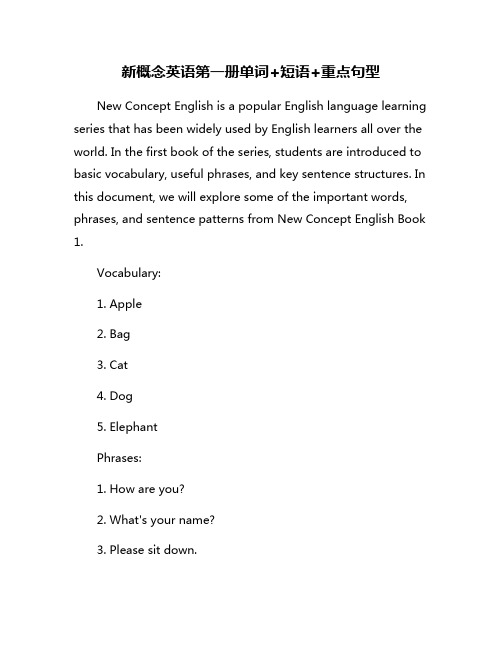
新概念英语第一册单词+短语+重点句型New Concept English is a popular English language learning series that has been widely used by English learners all over the world. In the first book of the series, students are introduced to basic vocabulary, useful phrases, and key sentence structures. In this document, we will explore some of the important words, phrases, and sentence patterns from New Concept English Book 1.Vocabulary:1. Apple2. Bag3. Cat4. Dog5. ElephantPhrases:1. How are you?2. What's your name?3. Please sit down.4. How do you do?5. What's the time?Key Sentence Patterns:1. Subject + Verb: The cat sleeps.2. Subject + Verb + Object: The dog eats meat.3. Subject + Verb + Adverb: She reads quickly.4. Subject + Verb + Adjective: He is tall.5. Subject + Verb + Object + Adverb: They sing songs loudly.As students progress through New Concept English Book 1, they will become more familiar with these words, phrases, and sentence patterns. By practicing them regularly, students can improve their English language skills and become more confident in using English in everyday conversations.In conclusion, New Concept English Book 1 is a great resource for English learners to build a solid foundation in the language. By mastering the basic vocabulary, useful phrases, and key sentence patterns introduced in this book, students can develop their English proficiency and communicate effectively in English-speaking environments.。
新概念英语第一册重点词汇和语法(完整版)
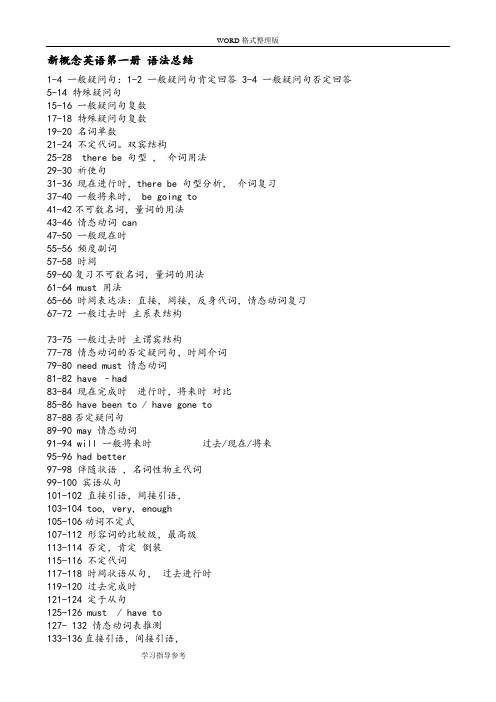
新概念英语第一册语法总结1-4 一般疑问句:1-2 一般疑问句肯定回答 3-4 一般疑问句否定回答5-14 特殊疑问句15-16 一般疑问句复数17-18 特殊疑问句复数19-20 名词单数21-24 不定代词。
双宾结构25-28 there be 句型,介词用法29-30 祈使句31-36 现在进行时,there be 句型分析,介词复习37-40 一般将来时, be going to41-42不可数名词,量词的用法43-46 情态动词 can47-50 一般现在时55-56 频度副词57-58 时间59-60复习不可数名词,量词的用法61-64 must 用法65-66 时间表达法:直接,间接,反身代词,情态动词复习67-72 一般过去时主系表结构73-75 一般过去时主谓宾结构77-78 情态动词的否定疑问句,时间介词79-80 need must 情态动词81-82 have –had83-84 现在完成时进行时,将来时对比85-86 have been to / have gone to87-88否定疑问句89-90 may 情态动词91-94 will 一般将来时过去/现在/将来95-96 had better97-98 伴随状语,名词性物主代词99-100 宾语从句101-102 直接引语,间接引语,103-104 too, very, enough105-106动词不定式107-112 形容词的比较级,最高级113-114 否定,肯定倒装115-116 不定代词117-118 时间状语从句,过去进行时119-120 过去完成时121-124 定于从句125-126 must / have to127- 132 情态动词表推测133-136直接引语,间接引语,137-138 条件状语从句139-140宾语从句141-144 被动语态Lesson 1 Excuse me1. Words1) excuse (1)重音(2)与sorry 的区别(3)Excuse 用的不同场景a. 请别人让路b. 引起别人的注意c. 打断别人的谈话d. 可以当n. 借口 eg. No excuse. 别找借口,没有借口。
新概念1知识点

新概念1知识点一、词汇。
1. 基础词汇。
- 数字:one, two, three等,要掌握数字的拼写、读音以及基本的数学运算表达,如“two plus three is five”(二加三等于五)。
- 家庭成员:father, mother, son, daughter, brother, sister等,学会描述家庭关系,例如“My father is a teacher”(我的父亲是一名教师)。
- 颜色:red, blue, green, black, white等,能够用颜色描述物品,如“This pen is blue”(这支笔是蓝色的)。
- 日常用品:pen, pencil, book, bag, desk, chair等,可用于描述周围环境或个人物品,如“There is a book on the desk”(桌子上有一本书)。
2. 动词短语。
- 起床:get up,例如“I get up at seven o'clock every morning”(我每天早上七点起床)。
- 去上学:go to school,如“He goes to school by bike”(他骑自行车去上学)。
- 吃(饭):have/eat,“I have breakfast at home”(我在家吃早饭)。
3. 方位介词。
- in:表示在……里面,如“There is a cat in the box”(盒子里有一只猫)。
- on:表示在……上面(表面接触),“The book is on the table”(书在桌子上)。
- under:表示在……下面,“The ball is under the chair”(球在椅子下面)。
二、语法。
1. 一般现在时。
- 概念:表示经常发生的动作或存在的状态。
- 结构:- 主语是第三人称单数(he/she/it等)时,动词要加 -s或 -es。
例如“He likes reading books”(他喜欢读书)。
最全的新概念英语第一册语法汇总
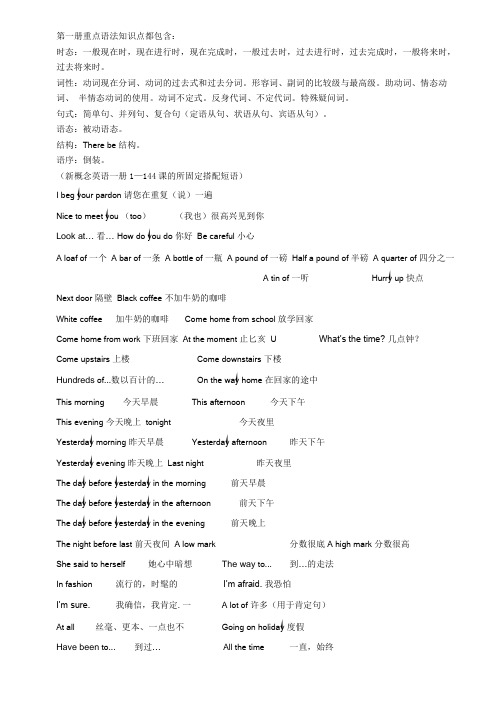
第一册重点语法知识点都包含:时态:一般现在时,现在进行时,现在完成时,一般过去时,过去进行时,过去完成时,一般将来时,过去将来时。
词性:动词现在分词、动词的过去式和过去分词。
形容词、副词的比较级与最高级。
助动词、情态动词、半情态动词的使用。
动词不定式。
反身代词、不定代词。
特殊疑问词。
句式:简单句、并列句、复合句(定语从句、状语从句、宾语从句)。
语态:被动语态。
结构:There be结构。
语序:倒装。
(新概念英语一册1—144课的所固定搭配短语)I beg your pardon 请您在重复(说)一遍Nice to meet you (too)(我也)很高兴见到你Look at… 看… How do you do 你好Be careful 小心A loaf of 一个 A bar of 一条 A bottle of 一瓶 A pound of 一磅Half a pound of 半磅 A quarter of 四分之一A tin of 一听Hurry up 快点Next door 隔壁Black coffee 不加牛奶的咖啡White coffee 加牛奶的咖啡Come home from school放学回家Come home from work 下班回家At the moment 止匕亥U What’s the time? 几点钟?Come upstairs 上楼Come downstairs 下楼Hundreds of...数以百计的…On the way home 在回家的途中This morning 今天早晨This afternoon 今天下午This evening 今天晚上tonight 今天夜里Yesterday morning 昨天早晨Yesterday afternoon 昨天下午Yesterday evening 昨天晚上Last night 昨天夜里The day before yesterday in the morning 前天早晨The day before yesterday in the afternoon 前天下午The day before yesterday in the evening 前天晚上The night before last 前天夜间 A low mark 分数很底A high mark 分数很高She said to herself 她心中暗想The way to... 到…的走法In fashion 流行的,时髦的I’m afraid. 我恐怕I’m sure.我确信,我肯定.一 A lot of 许多(用于肯定句)At all 丝毫、更本、一点也不Going on holiday 度假Have been to... 到过…All the time 一直,始终Have been to…到过…Drive into…撞倒.•・For sale 供出售、出售Have the last word 最后决定、最后才算The R.A.F. 英国皇家空军Return ticket 往返票Next door to... 与..•相邻,在..•隔壁In five hours’time在五小时之后。
新概念英语第一册所有语法点汇总)
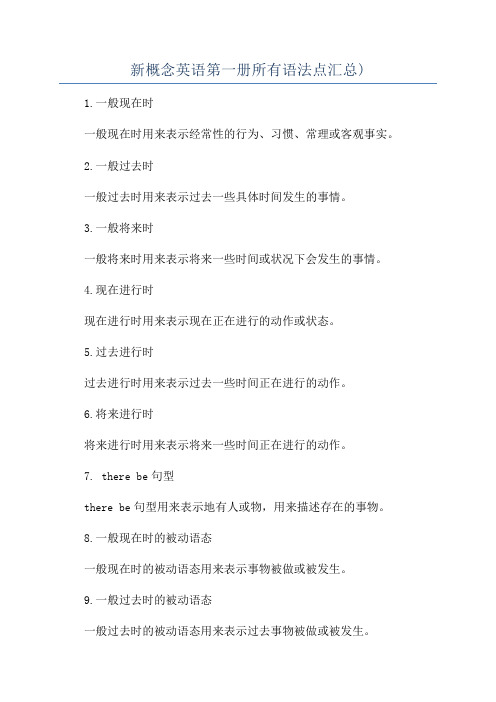
新概念英语第一册所有语法点汇总)1.一般现在时一般现在时用来表示经常性的行为、习惯、常理或客观事实。
2.一般过去时一般过去时用来表示过去一些具体时间发生的事情。
3.一般将来时一般将来时用来表示将来一些时间或状况下会发生的事情。
4.现在进行时现在进行时用来表示现在正在进行的动作或状态。
5.过去进行时过去进行时用来表示过去一些时间正在进行的动作。
6.将来进行时将来进行时用来表示将来一些时间正在进行的动作。
7. there be句型there be句型用来表示地有人或物,用来描述存在的事物。
8.一般现在时的被动语态一般现在时的被动语态用来表示事物被做或被发生。
9.一般过去时的被动语态一般过去时的被动语态用来表示过去事物被做或被发生。
10.一般将来时的被动语态一般将来时的被动语态用来表示将来事物将被做或被发生。
11.现在进行时的被动语态现在进行时的被动语态用来表示事物正在被做或被发生。
12.过去进行时的被动语态过去进行时的被动语态用来表示过去事物正在被做或被发生。
13. do与does的用法do和does用来构成否定句、疑问句和回答。
14.现在完成时现在完成时用来表示过去发生的动作对现在造成的影响或结果。
15.现在完成进行时现在完成进行时用来表示从过去开始一直延续到现在的动作,且这个动作可能还会继续下去。
16.过去完成时过去完成时用来表示过去在一些时间或事件之前已经完成的动作。
17.过去完成进行时过去完成进行时用来表示过去一些时间持续进行的动作,这个动作在另一个过去时间之前已经结束。
18.表示数量的词表示数量的词包括数词、基数词、序数词、分数和百分数等。
19.表示频率的词表示频率的词用来描述件事情发生的频率,如常常、经常、有时、很少、从不等。
20.表示时间的词表示时间的词用来描述一些事件发生的时间,如年、月、日、星期、时、分、秒等。
21.表示地点的词表示地点的词用来描述一些事件发生的地点,如国家、城市、街道、大楼等。
新概念英语第一册全书重点知识整理汇总
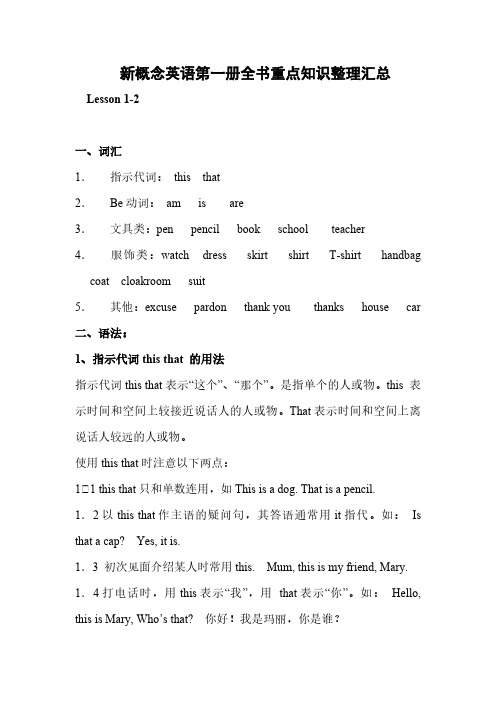
新概念英语第一册全书重点知识整理汇总Lesson 1-2一、词汇1.指示代词:this that2.Be动词:am is are3.文具类:pen pencil book school teacher4.服饰类:watch dress skirt shirt T-shirt handbag coat cloakroom suit5.其他:excuse pardon thank you thanks house car二、语法:1、指示代词this that 的用法指示代词this that表示“这个”、“那个”。
是指单个的人或物。
this 表示时间和空间上较接近说话人的人或物。
That表示时间和空间上离说话人较远的人或物。
使用this that时注意以下两点:1.1 this that只和单数连用,如This is a dog. That is a pencil.1.2以this that作主语的疑问句,其答语通常用it指代。
如:Is that a cap? Yes, it is.1.3 初次见面介绍某人时常用this. Mum, this is my friend, Mary. 1.4打电话时,用this表示“我”,用that表示“你”。
如:Hello, this is Mary, Who’s that? 你好!我是玛丽,你是谁?2、be动词的用法Be动词通常在句中做谓语,基本形式有is/am/are (以下是对应人称代词的固定搭配)I am=I’m You are = You’re He is = He’s She is = She’s It is = It’sWe are = We’re They are = They’re3、陈述句、一般疑问句陈述句:This is your handbag. 陈述句变一般疑问句:Is this your handbag?陈述句变一般疑问句方法四步:3.1 找出陈述句中的助动词,如is am are 3.2 助动词大写提前至句首。
(完整版)新概念英语第一册所有语法点汇总)

新概念英语第一册所有语法点汇总Lesson 1 人称代词含有be动词的陈述句、否定句和一般疑问句Lesson 3 祈使句简单的倒装句Lesson 5 冠词Lesson 6 选择疑问句Lesson 7 特殊疑问句一般疑问句Lesson 9 How…?的一些社交上的用法形容词的意义与作用Lesson 11所有格形容词和所有格代词名词所有格Lesson 15 名词可数名词单数变复数的规则Lesson 16 名词复数-s或-es的发音规则Lesson 19 There be句型常见方位介词:in、on、over、under Lesson 21 动词的双宾语Lesson 23 定语Lesson 27 some, any一些Lesson 29 情态动词情态动词must的用法Lesson 31 时态:共十六种时态,时态是通过动词变化来实现的。
现在进行时Lesson 34 动词+ing的规则Lesson 35 短语动词Lesson 37 be going to句型宾语补足语Lesson 39 祈使句do的用法Lesson 40 词组:动词+介词Lesson 43 情态动词can的用法Lesson 47 一般现在时Lesson 48 序数词Lesson 49 动词加s(es) 规则动词不定式some、any用法Lesson 51 What…(be,look…) like? 频率副词Lesson 57 一般现在时与现在进行时Lesson 59 have/has的用法Lesson 61 主语+系动词+表语Lesson 63 each和every的区别Lesson 64 禁令Don’t and Mustn’tLesson 65 日期的表达反身代词Lesson 67 一般过去时动词的过去式变化否定疑问句Lesson 69 用介词at,on和in的时间短语Lesson 74 副词的用法副词的构成Lesson 75 宾语从句Lesson 79 Must与NeedLesson 83 现在完成时Lesson 85 现在完成时的特殊结构Lesson 89 for与sinceLesson 91 一般将来时Lesson 95 had better和mustLesson 99 宾语从句Lesson 100 直接引语和间接引语Lesson 101 反意疑问句Lesson 103 too与enough的用法Lesson 105 动词不定式Lesson 107 形容词的比较级和最高级Lesson 111 形容词的平级比较级Lesson 113 so与neither引导的简短回答Lesson 116 不定代词Lesson 117 过去进行时概念和结构Lesson 119 过去完成时Lesson 121 定语从句Lesson 123 感叹句Lesson 125 must, have to和needn’tLesson 127 表示猜测和推断的情态助动词must和can’tLesson 131 情态助动词may表示可能性Lesson 133 需改变时态的间接陈述句Lesson 135 Let的用法Lesson 137 条件从句Lesson 141 被动语态新概念英语第一册语法点归纳大纲新概念英语第一册语法点归纳新概念一共144课,其中单课为课文,双课为语法和练习。
新概念英语第一册知识点总结
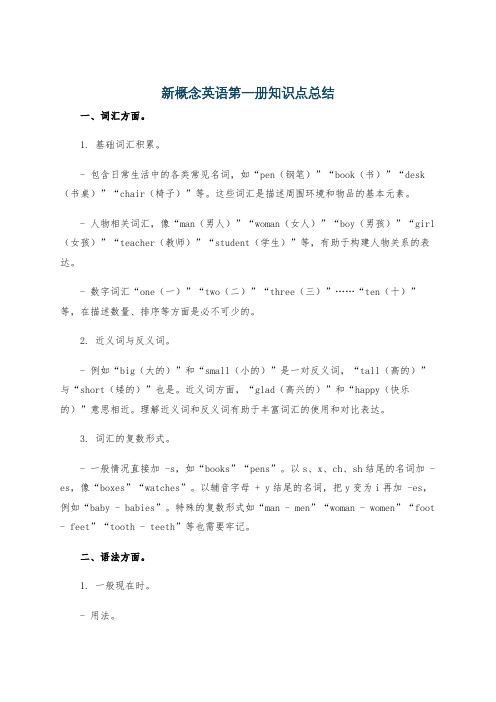
新概念英语第一册知识点总结一、词汇方面。
1. 基础词汇积累。
- 包含日常生活中的各类常见名词,如“pen(钢笔)”“book(书)”“desk (书桌)”“chair(椅子)”等。
这些词汇是描述周围环境和物品的基本元素。
- 人物相关词汇,像“man(男人)”“woman(女人)”“boy(男孩)”“girl (女孩)”“teacher(教师)”“student(学生)”等,有助于构建人物关系的表达。
- 数字词汇“one(一)”“two(二)”“three(三)”……“ten(十)”等,在描述数量、排序等方面是必不可少的。
2. 近义词与反义词。
- 例如“big(大的)”和“small(小的)”是一对反义词,“tall(高的)”与“short(矮的)”也是。
近义词方面,“glad(高兴的)”和“happy(快乐的)”意思相近。
理解近义词和反义词有助于丰富词汇的使用和对比表达。
3. 词汇的复数形式。
- 一般情况直接加 -s,如“books”“pens”。
以s、x、ch、sh结尾的名词加 -es,像“boxes”“watches”。
以辅音字母 + y结尾的名词,把y变为i再加 -es,例如“baby - babies”。
特殊的复数形式如“man - men”“woman - women”“foot - feet”“tooth - teeth”等也需要牢记。
二、语法方面。
1. 一般现在时。
- 用法。
- 表示经常或习惯性的动作或状态。
例如:I get up at six every day.(我每天六点起床。
)- 表示客观事实或真理。
The earth goes around the sun.(地球绕着太阳转。
)- 句子结构。
- 主语为第三人称单数(he/she/it等)时,动词要加 -s或 -es。
如:He likes reading.(他喜欢阅读。
)- 主语为第一人称(I)、第二人称(you)以及复数主语(we/they等)时,动词用原形。
最全的新概念英语第一册语法汇总
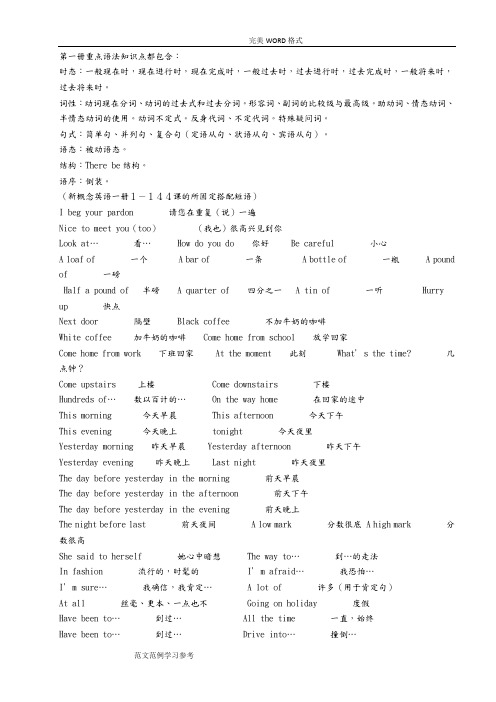
第一册重点语法知识点都包含:时态:一般现在时,现在进行时,现在完成时,一般过去时,过去进行时,过去完成时,一般将来时,过去将来时。
词性:动词现在分词、动词的过去式和过去分词。
形容词、副词的比较级与最高级。
助动词、情态动词、半情态动词的使用。
动词不定式。
反身代词、不定代词。
特殊疑问词。
句式:简单句、并列句、复合句(定语从句、状语从句、宾语从句)。
语态:被动语态。
结构:There be结构。
语序:倒装。
(新概念英语一册1-144课的所固定搭配短语)I beg your pardon 请您在重复(说)一遍Nice to meet you(too)(我也)很高兴见到你Look at…看… How do you do 你好 Be careful 小心A loaf of 一个 A bar of 一条 A bottle of 一瓶 A pound of 一磅Half a pound of 半磅 A quarter of 四分之一 A tin of 一听 Hurry up 快点Next door 隔壁 Black coffee 不加牛奶的咖啡White coffee 加牛奶的咖啡 Come home from school 放学回家Come home from work 下班回家 At the moment 此刻What’s the time?几点钟?Come upstairs 上楼 Come downstairs 下楼Hundreds of…数以百计的… On the way home 在回家的途中This morning 今天早晨 This afternoon 今天下午This evening 今天晚上 tonight 今天夜里Yesterday morning 昨天早晨 Yesterday afternoon 昨天下午Yesterday evening 昨天晚上 Last night 昨天夜里The day before yesterday in the morning 前天早晨The day before yesterday in the afternoon 前天下午The day before yesterday in the evening 前天晚上The night before last 前天夜间 A low mark 分数很底 A high mark 分数很高She said to herself 她心中暗想The way to…到…的走法In fashion 流行的,时髦的I’m afraid…我恐怕…I’m sure…我确信,我肯定… A lot of 许多(用于肯定句)At all 丝毫、更本、一点也不 Going on holiday 度假Have been to…到过… All the time 一直,始终Have been to…到过… Drive into…撞倒…For sale 供出售、出售 Have the last word 最后决定、最后才算The R.A.F. 英国皇家空军 Return ticket 往返票Next door to…与…相邻,在…隔壁In five hours’time在五小时之后。
新概念英语第一册语法总结

一.时态:一般现在时,现在进行时,一般过去时,现在完成时,一般将来时,过去进行时,过去完成时,过去将来时1. 一般现在时表示一般性,经常性的动作或一般性事实。
含有be动词的句子He is a teacher.The girl is very beautiful.Tim and Jack are students.★变疑问句将be动词移到句首Is he a teacher?Is the girl very beautiful?Are Tim and Jack students?★变否定句在be动词后面加notHe is not a teacher.The girl is not very beautiful.Tim and Jack are not students.★肯定回答及否定回答Yes, he is. No, he is not.Yes, she is. No, she is not.Yes, they are. No, they are not.不含有动词的句子,即含有一般动词的句子第三人称单数及单数名词He likes books.She likes him.The dog likes bones.★变疑问句在句首加does, 动词变为原型Does he like books?Does she like him?Does the dog like bones?★变否定句在主语及动词之间加doesn’t, 动词变为原型He doesn’t like books.She doesn’t like him.The dog doesn’t like bones.★肯定回答及否定回答:Yes, he does. No, he doesn’t.Yes, she does. No, she doesn’tYes, it does. No, it doesn’t.注意:第三人称单数形式一般在动词后面加S,不要和名词复数混淆,变否定句或疑问句时名词复数没有任何变化。
新概念第一册语法知识点汇总(完美版)
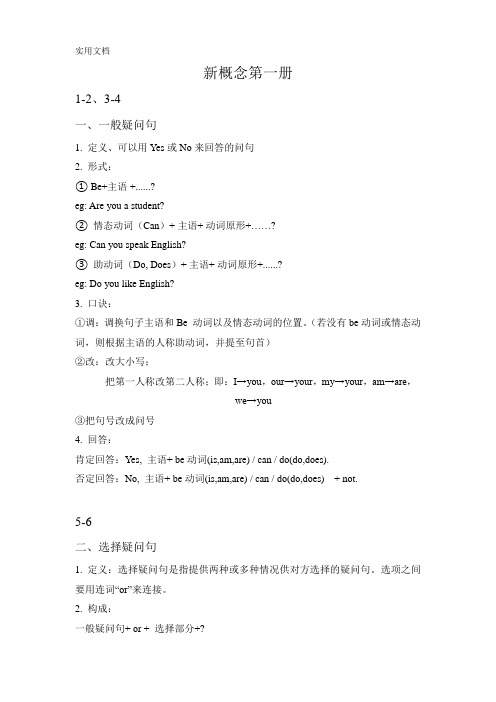
新概念第一册1-2、3-4一、一般疑问句1. 定义、可以用Yes或No来回答的问句2. 形式:① Be+主语 +......?eg: Are you a student?②情态动词(Can)+ 主语+ 动词原形+……?eg: Can you speak English?③助动词(Do, Does)+ 主语+ 动词原形+......?eg: Do you like English?3. 口诀:①调:调换句子主语和Be 动词以及情态动词的位置。
(若没有be动词或情态动词,则根据主语的人称助动词,并提至句首)②改:改大小写;把第一人称改第二人称;即:I→you,our→your,my→your,am→are,we→you③把句号改成问号4. 回答:肯定回答:Yes, 主语+ be动词(is,am,are) / can / do(do,does).否定回答:No, 主语+ be动词(is,am,are) / can / do(do,does) + not.5-6二、选择疑问句1. 定义:选择疑问句是指提供两种或多种情况供对方选择的疑问句。
选项之间要用连词“or”来连接。
2. 构成:一般疑问句+ or + 选择部分+?例:Are you a doctor or a teacher? 你是一个医生还是教师?Does he like this or that? 他喜欢这个还是喜欢那个?Is that coffee yours or hers? 这咖啡是你的还是她的?注:有时候选择部分会用“or not”来表示例:Are you ready or not (ready) ? 你准备好没有?Do you like the film or not? 你喜不喜欢这部电影?7-8、11-12、13-14三、特殊疑问句1. 含义:以特殊疑问词开头的疑问句。
2. 构成:特殊疑问词+一般疑问句+?3. 特殊疑问词总结:(1) what 什么(职业,姓名等)what day 星期几What day is it today? 几天星期几?what size 多大尺码What size are your shoes? 你的鞋码多大?what time 什么时间What time is it now? 现在几点了?what colour 什么颜色What color is your schoolbag? 你的书包是什么颜色?(2) when 什么时候(就时间提问)When will you visit Beijing? 你什么时候去北京玩?(3) where 什么地方(就地点提问)Where is your hometown? 你的家乡在哪?(4) who 谁(问人的身份,姓名等)Who is the girl in red dress? 穿着红裙子的女生是谁?(5) whose 谁的(whose + n.)Whose book is this?这是谁的书?(6) which 哪一个;哪些Which one is your sister ? 哪一个是你姐姐?(7) why 为什么(就原因提问,常用because回答)Why did you break the window?你为什么要打破窗户?(8) how 怎么样How do you go to school? 你怎么去学校?how many多少(提问可数名词数量)How many books do you have ?你有几本书?how much 多少(提问不可数名词数量)How much water is there in the glass?玻璃杯里有多少水?how much 多少钱(提问价格)How much is the ruler? 这把尺子多少钱?how old 几岁(提问年龄)How old are you? 你多少岁了?how long 多长(提问长度)How long is this ruler? 这把尺子有多长?多长时间(时间持续多久)How long do you go to school? 你去学校要多长时间?how often 多久一次(提问频率既单位时间发生多少次)how soon (还要多久时间才能开始或结束)How soon will he come back? 他多久才能回来?how heavy(提问有多重)How heavy is the luggage?这个行李箱有多重?9-10四、祈使句1. 定义:用于表达命令、请求、劝告、警告等的句子叫做祈使句。
(完整版)新概念英语1A知识点总结
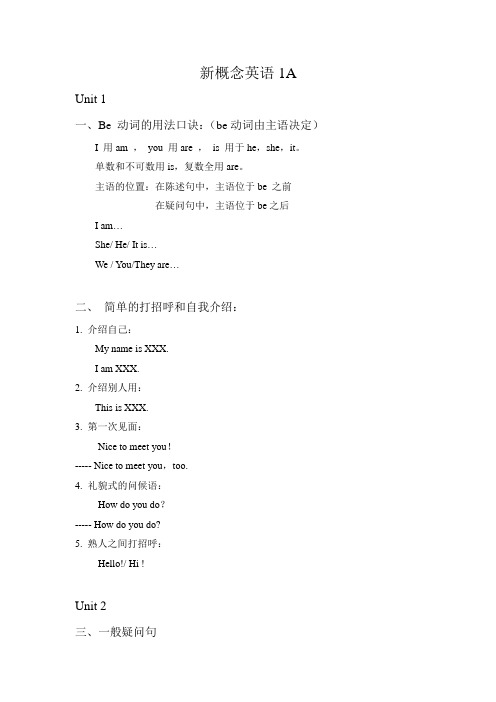
新概念英语1A Unit 1一、Be 动词的用法口诀:(be动词由主语决定)I 用am ,you 用are ,is 用于he,she,it。
单数和不可数用is,复数全用are。
主语的位置:在陈述句中,主语位于be 之前在疑问句中,主语位于be之后I am…She/ He/ It is…We / You/They are…二、简单的打招呼和自我介绍:1. 介绍自己:My name is XXX.I am XXX.2. 介绍别人用:This is XXX.3. 第一次见面:Nice to meet you!----- Nice to meet you,too.4. 礼貌式的问候语:How do you do?----- How do you do?5. 熟人之间打招呼:Hello!/ Hi !Unit 2三、一般疑问句1. 定义(什么叫做一般疑问句):可以用Yes或No来回答的问句。
2. 陈述句变一般疑问句步骤(怎么变?):①调:调换主语与be 的位置到句首。
②改:A:改写大小。
B:该人称:I(我)→you(你),we(我们)→you(你们),my (我的)→your(你的),am(用于I)→are(用于you等复数人称)C:将句号“.”改成问号“?”3. 回答:①肯定回答:Yes,主语+be.②否定回答:No,主语+be+not. (am与not不缩写)例:陈述句:This is my pen. 这是我的钢笔。
一般疑问句:Is this your pen? 这是你的钢笔吗?肯定回答:Yes, it is. 是的,这是我的钢笔。
否定回答:No, it is not(isn’t). 不,这不是我的钢笔。
4. Be动词的否定式:①:Be 的现在式:am , is , are②:Be 的过去式:was ,were③:否定式:is not= isn’t , are not=aren’t , am not无缩写形式四、冠词a/ an 的用法1. a + 以辅音发音开头的单词例:a hat , a man , a university [ˌju:nɪˈvɜ:səti]an + 以元音发音开头的单词例:an apple [ˈæpl] ,an orange [ˈɒrɪndʒ],an egg [eg],an uncle [ˈʌŋkl],an hour [ˈaʊə(r)]2. 单个字母出现在“Mr Li has one fox”中任何一个字母均用an例:an M an H an SUnit 3五、特问词的运用1. 特问词:What 问物(什么)How old 问年龄(多少岁)Who 问人(谁)How many/ much…?多少…?Whose 问谁的How 怎样What colour 问颜色Where 问哪里Which 哪一个(选择)When 问时间(什么时候)=what time2.例子① What is this?(问物)---- It is a bicycle. It is a silver bicycle.② Whose is this umbrella ?(问谁的)---- It’s William’s.③ What colour is Robert’s bicycle? (问颜色+问谁的)---- Robert’s bicycle is silver.六、对划线部分提问的做题技巧1. 选特问词。
(完整版)最全新概念英语第一册语法汇总,文档

时态:大凡现在时,现在进行时,现在完成时,大凡过去时,过去进行时,过去完成时,大凡将来时,过去将来时。
性:在分、的去式和去分。
形容、副的比与最高。
助、情、半情的使用。
不定式。
反身代、不定代。
分外疑。
句式:句、并列句、复合句〔定从句、状从句、从句〕。
:被。
构: There be构。
序:倒装。
〔新看法英一册1-144的所不搭配短〕I beg your pardon 您在重复〔〕一遍Nice to meet you〔too〕〔我也〕很高到你Look at 看⋯⋯ How do you do你好 Be careful小心A loaf of 一个 A bar of 一条 A bottle of 一瓶 A pound of 一磅 Half a pound of 半磅 A quarter of 四分之一 A tin of 一听 Hurry up 快点 Next door 近邻 Black coffee 不加牛奶的咖啡White coffee 加牛奶的咖啡 Come home from school 放学回家Come home from work 下班回家 At the moment 现在 What’ s the time?几点? Come upstairs上楼 Come downstairs下楼Hundreds of 数⋯以百的⋯ On the way home在回家的途中This morning 今天清早 This afternoon 今天下午This evening今天夜晚 tonight 今天夜里Yesterday morning 昨天清早 Yesterday afternoon 昨天下午Yesterday evening昨天夜晚 Last night 昨天夜里The day before yesterday in the morning前天清早The day before yesterday in the afternoon 前天下午The day before yesterday in the evening前天夜晚The night before last 前天夜 A low mark 分数很底 A high mark 分数很高She said to herself她心中暗想 The way to 到⋯⋯的走法In fashion 流行的,髦的I ’ m afraid我恐⋯怕⋯I ’ m sure我⋯确信,我必然⋯ A lot of多〔用于必然句〕At all 毫、更本、一点也不Going on holiday 度假Have been to 到⋯⋯ All the time素来,始Have been to 到⋯⋯ Drive into 撞倒⋯⋯For sale 供销售、销售 Have the last word 最后决定、最后才算英.国皇家空Return ticket 往返票Next door to与⋯相,在⋯近邻In five hours’在time五小此后。
- 1、下载文档前请自行甄别文档内容的完整性,平台不提供额外的编辑、内容补充、找答案等附加服务。
- 2、"仅部分预览"的文档,不可在线预览部分如存在完整性等问题,可反馈申请退款(可完整预览的文档不适用该条件!)。
- 3、如文档侵犯您的权益,请联系客服反馈,我们会尽快为您处理(人工客服工作时间:9:00-18:30)。
New Concept English Book 1Revision Lesson 1—78重点词汇一.名词服装:clothes handbag watch coat dress skirt shirt blouse tie hat suit shoe trousers pocket交通:way car ship aeroplane食物:food ice cream bone cheese bread soap chocolate sugar cake biscuit egg butter honey jam meat beef lamb steak mince chicken milk water tea coffee Scotch whisky wine beer tomato potato cabbage lettuce pea bean apple pear grape peach orange banana称呼:Mrs. Mr. Miss name father mother mum grandfather grandmother sister brother son daughter sir wife husband girl boy child children man woman friend baby winner tourist 职业:job keyboard operator engineer policeman policewoman taxi driver air hostess postman nurse mechanic hairdresser housewife milkman customs officer employee sales repsoffice assistant teacher student boss butcher doctor dentist shop assistant greengrocer bakergrocer stationer年月:year January February March April May June July August September October November December星期:week Sunday Monday Tuesday Wednesday Thursday Friday Saturday weekend季节:season spring summer autumn winter动物:dog cat bird地点:garden village park school shop church dairy library town生活:case carpet box glass cup bottle tin knife fork spoon shelf table plate cupboard cigarette tobacco television dressing table magazine bed newspaper stereo refrigerator electric cooker armchair picture wardrobe basket tap bookcase hammer dish kettle teapotvase envelope writing paper pad glue change family photograph match telephone key letter housework passport fashion umbrella ticket news appointment noise学校:pen pencil book desk chalk blackboard homework handwriting subject conversation phrase phrasebook颜色:colour white black green blue red yellow pink gray purple brown orange房子:building house room window door floor wall living room kitchen bedroom cloakroom方位:right left middle front north south east west时间:time day morning afternoon evening night moment疾病:matter headache earache toothache stomach ache cold temperature flu measles mumps aspirin 自然界:tree grass cloud sky sun bridge boat river valley hill bank flower weather climate身体部位:tooth teeth mouth tongue hand量词短语:a pair of,a loaf of, a bar of, a bottle of, a pound of, half a pound of, a quarter of,a tin of ,a bowl of , a piece of , a bunch of , a carton of , a cup of , a glass of, a basket of国家-国籍:country ——nationalityChina—Chinese Japan—Janpanese England—English America—American Korea—Korean Russia—Russian France—French Germany—German Brazil—Brazilian Holland—Dutch Italy—Italian Norway—Norwegian Spain—Spanish Sweden—Swedish Australia—Australian Austra—Austrian Canada—Canadian Finland—Finnish India—Indian Nigeria—Nigerian Turkey—Turkish Poland—Polish Thailand—Thai其他truth lunch size race crowd finish二.动词1.be 动词:am is are were was2.情态动词:can could must may shall should will would3.“有”动词:have has4.助动词:do does did5.实意动词:excuse meet see look watch catch come give shut open air put dust sweep empty read sharpen put on take off turn on turn off climb run type eat clean cook drink shine walk fly sleep shave cry wash wait jump swim make listen drop show send take find boil ask liftlike want tell rain snow rise set live stay arrive feel call remember remain play talk drive break hear enjoy keep spend stand telephone answer say smile understand speak cut go greet buy wear三、形容词big-small new-old-young fat- thin long-short-tall dirty-clean hot-cold open-shut empty-full light-heavy large-little sharp-blunt good-bad laz y—hard-working busy-free left-right tidy-untidy lucky-unlucky same-different comfortable-uncomfortable smart nice fine well lovely tired thirsty favourite careful terrible fresh pure ripe choice pleasant mild wet interesting rich absent sweet exciting awful last urgent white black green blue red yellow pink四、副词upstairs downstairs hard either always well better best early late o’clock certainly so quickly just again ago together home pleasantly slowly hurriedly suddenly thirstily warmly usually terribly badly late fast yet五、介词in on near (next to/ beside) under over with between behind along across off into out of in front of at六、数词基数词:number one two three four five six seven eight nine ten eleven twelve thirteen fourteen fifteen sixteen seventeen eighteen nineteen twenty twenty-one thirty forty fifty sixty seventy eighty ninety hundred thousand序数词:the first the second the third the fourth the fifth the sixth the seventh the eighth the ninth the tenth the eleventh the twelfth the thirteenth the fourteenth the fifteenth the sixteenththe seventeenth the eighteenth the nineteenth the twentieth the thirtieth the fortieth the fiftieth the sixtieth the seventieth the eightieth the ninetieth the one hundredth七、人称代词主格I You He She It We You They宾格me you him her it us you them形容词性物主代词my your his her its our your their名词性物主代词mine yours his her its ours yours theirs反身代词myself yourself himself herself itself ourselves yourselves themselves重点句型1. Is this your…? Yes, it is. No, it isn’t.2. Are these …? Yes, they are. No, they aren’t.3. What’s your job? I’m a/an…4. What are their jobs? They’re….5. Look at…6. Whose is this/that …? This/That is my/your/his/her…7. What colour is …? It’s….8. What colour are …? They’re….9. Give me/him/her/us/them a/some…10. Which one? Which ones?11. Where is it? It’s in/on/under/near/beside/next to/behind/in front of/between….12. Where are they? They’re….13. There be…There is a/an/some+不可数名词…+介词短语。
